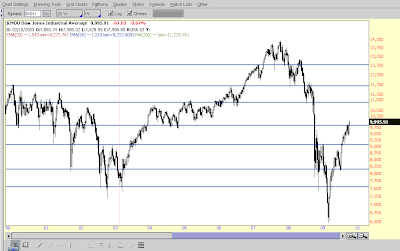Somehow the bulls managed to bounce this market to make it appear bullish once again.I had been mentioning that I was not entirely convinced that yesterday's break of the trendline was entirely bearish. It was not a surprise because they pulled this trick in July in regards to the head and shoulders. I'm looking at this in two ways:
1) Just like in July they got everyone short on the break of the trendlines (this is evident in the heavy selling volume in the index ETFS and market breadth). The short covering rally will attract more buyers and the market may attempt a run to 1121, and perhaps even 1230 (doubtful).
2) We've been trained to buy the dips, but the trendline is now broken. In addition so many others things that I've already pointed out give strong evidence that the top IS in. Therefore people will begin to buy these dips, but the market will make a quick turnaround next week and all these new buyers will allow the market to go lower.
The chart above shows a regression channel on the S&P. It just shows how systematic this uptrend has been lately. Up and down making higher highs and higher lows. Take note that yesterday's and today's actions are very typical for a reversal. I like this 2 day candle pattern even more than a hammer or shooting star. It typically occurs by having two full bodied candles, one up and one down, going through important support/resistance in the 1st and reversing back and saving support/resistance in the 2nd.
The Nasdaq
The Nasdaq and Transports both were weaker than the Dow today. However any further upside would favor at least a retest of highs, disregarding my #2 scenario described above. Note the major RSI divergence occurring on the daily. Just as we've had a nice uptrend in stocks, the RSI has continued in a nice downtrend. Not a good sign.
S&P 400 Mid Index
The S&P 400 Mid was a favorite for me back in December when I was comparing the charts to the 1938 scenerio. I liked the structure a bit better. It seems to be a mix of the Nasdaq and the S&P 500. Notice how the retracements have played a very significant role in defining support. Currently it appears the Mid is obeying its rally trendline, unlike all other indexes. Support was found by the intersection of the trendline and the 50% retracement. Perhaps this is the one to continue to watch. This chart tends to make me believe we will reach the 61.8% retracement.
McClellan Oscillator
Chart courtesy of McClellan Financial Publications
To substitute my normal discussion on market breadth I'm posting a popular picture posted on many blogs recently of the McClellan Oscillator. For those unaware you can read investopedia's definition here. You can notice that the oscillator was significantly in oversold range. In fact it was at it lowest levels since the rally began, and as levels such as the November and March Lows. It also appears as if there is a very good possibility we will see a bit more upside, perhaps until it gets to -100 in the chart above.
Whats up with Goldman?
GDP came in better than expected today at 3.5%. Yesterday Goldman Sachs downgraded their forecast from 3% to 2.7%. My questions are why do they update it the day before, why wait until the last second... (they do this a lot I've noticed). Also you would think that with new data they would have a more correct number, not make their forecast worse. Typically you think of Goldman as the cream of the crop, and if they are making these types of mistakes you almost automatically think manipulation. This plays into the #1 scenario I posted above, and yesterday gave Goldman the perfect opportunity to go long for the last major move up in this rally.
Perhaps Goldman knew that the GDP would come in at 3.5%, but instead they lower their forecast. (What do they got to lose by doing so) They know the market is in a state of fear and confusion, being down a good 5% from highs and breaking the major trendlines. They figure if they can get in investors' heads that the GDP number is important for the markets (which its shown its not) that they can make some money on the long side in an oversold bounce.
I don't know if I necessarily buy into the whole manipulation thing, but I can tell you a lot of people do. I will say theres a possibility this actually does occur, but perhaps people just cannot understand the reasons why markets move. As humans we typically want a reason (or an excuse) to why things happen the way they do. Perhaps blaming Goldman or the Fed is what we do when the market makes a move against us. Someone else has to get the blame, not ourselves.
Please check these links on Zerohedge for more information on Goldman and the GDP numbers:


















































